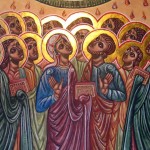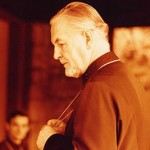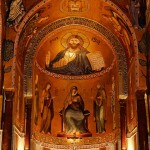Sermon Notes – Good Friday – Year B
Ecce homo – Here is the man
Thesis
We have arrived at Good Friday. Last night we had our feet washed, we shared the Lord’s Supper and our altars were stripped and washed. Tonight we arrive in solemnity. The “Hosannas” of Palm Sunday still ring in our ears and the “Alleluias” of Easter—those that have been hidden (unless your Orthodox) for Lent—are welling up inside our hearts. But. But we have to deal with the Cross. Actually, we have to deal with the man upon the cross—the one who gives the cross meaning.
Borrowing from Pilate’s phrase—ecce homo—this post will focus primarily on the person (both human and divine) of Jesus. When we read, “Here is the man” we should immediately begin asking, “Who is the man?” Indeed he is the Suffering Son of Man, the King of the Jews, our Great High Priest, and the Crucified One. And remember: God is glorified in Christ crucified!
Analysis
Collect
Today’s Collect sets the stage for us, per usual, by emphasizing the actions of Jesus. I don’t often desire to change any of the language in the collects but this one could use a minor tweak. That Jesus was willing to be betrayed is excellent, as is the statement that he suffered death upon the cross. The second statement is the one with which I taken issue: it is too passive. Jesus, as the Orthodox (yes, I’m quoting the Divine Liturgy AGAIN!) powerfully remind us, was not given into the hand of sinners but rather gave himself voluntarily into the hand of sinners. This is a far more powerful, active and accurate description.
Either way, the Collect makes it abundantly clear that the focus of Good Friday’s lessons is the person and work and Jesus. And if Good Friday is bad news to anyone, particularly people who have not yet heard the story, the final clause of the Collect (the clause that is always included) reminds us amidst our grief that Jesus lives and reigns with God. Even in the darkest hour there is hope and light because we live on the other side of the Empty Tomb.
I only reference the Collect this much to suggest that the three actions of Jesus are further highlighted by John’s Passion narrative (Chapters 18 and 19) and could therefore form part of your homiletic structure.
Old Testament
This is one of the Servant Songs of Isaiah, and it is certainly the most famous. Isaiah is writing words about God’s servant who will suffer at the hands of his enemies. It was a common belief amongst Jews that the servant was a metaphor for Israel because they had no category for a suffering Messiah. Indeed the Son of Man as depicted in Daniel 7 is more what Israel had in mind for her Messiah and therefore needed to reflect upon her troubled history to make sense of Isaiah.
However, the Gospel writers knew that Jesus was the Suffering Son of Man and that Daniel 7 could not be properly understood without reading it alongside Isaiah 52-53. This is what Richard Hays has argued in both Reading Backwards and “The Canonical Matrix of the Gospels.” Jesus and the New Testament writers were firmly planted within the Jewish story and therefore used the Old Testament as the interpretive matrix for that which had taken place. Suddenly Isaiah 52-53 is referring prophetically and directly to Jesus as the Faithful Israelite rather than Israel as a whole.
The imagery in this song ties directly into the Passion Narrative of John as we see that Jesus’ clothes were divided by lots, that he was bruised and beaten, his interaction with Pilate, and ultimately his death and burial. The correlations here are endless. The Good News is contained within: “The righteous one, my servant, shall make many righteous, and he shall bear their iniquities.” Through and in Jesus many are made righteous. His stripes and bruises heal us of our sins!
Look at the second to last verse: “He poured out himself unto death.” That’s not a passive comment in the least; this does not give the impression that Jesus happened to be in the wrong place at the wrong time. No! Jesus put himself in the right place and the right time because his journey was always toward the Cross, toward death, and toward victory. The Servant has to Suffer in order that all might be redeemed!
Psalm
N. T. Wright has suggested—and I agree with him—that the Psalms were the prayer book for Jesus. Being a (good) Jew, Jesus would have known the Psalms through and through as they formed the basis of Jewish prayer life. It is possible, even likely, that upon the cross Jesus recited the entirety of Psalm 22.
Notice the opening verse, it is indeed the same line that we read from Jesus during Palm Sunday when he cries out to God in Mark’s Gospel, “Eloi, eloi…” My God, my God why have your forsaken me?
I’ve heard a lot of preachers focus on this one line and come to the conclusion that this is simply a Psalm of lament on the lips of Jesus. Unfortunately to suggest that is to not read far enough. Let’s assume that Jesus did indeed recite the whole Psalm. Let’s assume again that Jesus did so not because the Psalm was about him but because the Psalms had formed him. We arrive at a much different picture! Psalm 22 ends up being a Psalm of praise! That which begins in lament ends in worship.
Jesus is therefore offering himself upon the cross as an act of worship. This is oblation. This is worship. Verses 1-21 are full of lament and they are followed up by verses 22-30 which can be considered praise in the face of lament. It is NOT that lament is wrong or that we need to stuff our negative feelings. This could not be further from the truth. Rather, it is that Jesus (and the Psalmist) is able to praise YHWH-who-reigns-over-all even in the midst of trials, tribulations, and death.
Coincidentally, that is what the liturgical use of the Psalms helps form within each individual: a repertoire of feelings, emotions, images and phrases all for the glory of God given in worship.
Epistle
There are two choices here but they focus on one main theme: Jesus as High Priest. Hebrews 4 was used a few weeks ago and should be fresh in your memory if you elect to preach from it on Good Friday. I’ll point you here for my thoughts on Hebrews 4-5 and reverent submission.
Hebrews 10 mirrors the description of the Tabernacle in the Old Testament. The parallels between the sacrifices offered in the Holy of Holies and the work of Jesus are numerous and significant (approaching, sprinkling, pure water). The author of Hebrews will also share elsewhere in the epistle that Jesus is now sitting down as our Great High Priest because his work has been accomplished. The sacrifices of the Old Testament, particularly Yom Kippur (Day of Atonement), were insufficient. Israel would annually make ritual atonement for her sins and she would need to do so the next year and the year after that, etc. Jesus sacrifice was full, complete, and sufficient and it was literally once for all.
The point here, and for all of Hebrews, is that Jesus is the Great High Priest unlike any other. He is like Moses but greater than Moses. He is like Melchizedek but greater than Melchizedek. In short, Jesus is the true High Priest and has offered a sacrifice—his self-sacrifice—on our behalf and Almighty God accepted it.
The veil has therefore been torn. We have an Advocate and Mediator in Jesus, giving us access to the triune God, and we are to approach with a humble confidence. Think of the Tabernacle—and the Temple—when reading this. Also remember that both Tabernacle/Temple were considered to be the meeting place of heaven and earth. Jesus is now that meeting place.
Gospel
We encounter another mammoth passage, but this time it is from John’s perspective rather than Mark’s. John’s “Book of Glory” gives us far more detail about Jesus’ interaction with Pilate and the reemergence of Nicodemus among other things. The story is the story is the story and rather than working through it bit by bit right now, I’d like to share a few tidbits that leap out to me. I’ll add some more work in the “Synthesis” section but honestly this is the central story of Christianity and shouldn’t require too much work to “bring to life.”
- Not of this world
Have you seen the t-shirts and other Christian paraphernalia in the last 5 years or so that read “NotW” or “Not of this World”? This is a quote taken from John 18 and yet it seems to have been misappropriated. The suggestion of this logo seems to be that we are not of this world and neither is Jesus. It seems to coincide with a belief—subconscious, I’m sure—that this world is passing away and we’ll be united with Jesus in the sky, in some heaven somewhere else.
N. T. Wright is quick to remind us that the Greek here can certainly be translated as “of” but it can also be translated as “from.” In fact, it should be translated as “from” in this instance. Jesus tells Pilate that his kingdom is not from this world. Please hear: unlike NotW or any other claim on Jesus, his kingdom is utterly for this world. There is no Docetism whatsoever in the Jesus’ Kingdom. We are not escaping this world. No, Jesus’ Kingdom is the promise of new creation, of a new heaven and a new earth that will be the same and yet radically different.
- Peter and Charcoal
John tells us that a charcoal fire is present in the courtyard when Peter denies the Lord three times. This is a random observation to include but we learn at the end of John’s Gospel: Peter’s reinstatement. Jesus and his disciples share a meal of grilled fish cooked over a charcoal fire, “When they had gone ashore, they saw a charcoal fire there, with fish on it, and bread. Jesus said to them, ‘Bring some of the fish that you have just caught,’” (John 21:9-10). The parallels continue when Peter is asked three times by Jesus if he loves him—three times to mirror the three denials. In short, that which was used for ill is now transformed, redeemed and used for good.
- Ecce homo – here is the man
John shares more of Jesus’ conversation with Pilate than the Synoptics. In this conversation we see that Jesus’ kingdom is not from this world, that Pilate only has power over Jesus that has been given him from above, and that Pilate is caught between a rock and a hard place.
Pilate presents Jesus before his people by saying, “Here is the man.” “Ecce homo,” and I think it’s extremely important that we keep Jesus’ humanity in full-scope. In The Purple Headed Mountain, Martin Thornton is keen to remind believers that Jesus was fully man. It would be easy to read John 18-19 by only highlighting Jesus’ divinity and therefore assuming that this caused him no pain, nor that he had to submit himself, nor that he would have felt hungry, tired, angry, saddened, humiliated, defeated, worshipful or anything else. But to strip Jesus of his humanity—however inadvertent such stripping may be—would be to rob the story of its central meaning: Jesus redeemed humanity by taking on human flesh; Jesus demonstrates to all of mankind what redeemed humanity looks like and calls us to follow; Jesus is indeed the man presented by Pilate and we should take his words literally.
- We have no king but the Emperor
The ruling powers of the Jewish people have sold themselves to Rome. Sure, they are already under foreign (Roman) occupation and are not free in the least, but they have now sold themselves completely from God to man by saying, “we have no king but the emperor.”
Your ears should be ringing with the words in 1 Samuel when Israel cried out that she wanted a king like all of the other nations. God knew that he was their one and true king but he allowed them to be ruled by men nonetheless. This was the beginning of the end of Israel because after the disaster of Saul we encounter David, Solomon and a long, long list of evil kings with only a few bright spots in between. The words in John 18-19 are no longer the beginning of the end but the end of the end and the beginning of a new dawn. For God is their true King and he will prove his kingship through the Cross and Empty Tomb, ultimately the Exaltation of Jesus to the right hand of God will be the final demonstration of his reign over all creation. God is King but do we recognize it?
- The re-emergence of Nic at Nite
Nicodemus makes his second appearance in John’s gospel. You’ll remember him from John 3 when he came to Jesus by cover of night and was given a mind-puzzle about being reborn. For 16 chapters we learn nothing more of Nic at Nite nor do we hear from him again. And then, when the hour is darkest and Jesus the Great Teacher is dead, Nicodemus emerges with Joseph of Arimathea and helps to bury him. We don’t know what happened to Nic in between John 3 and John 19, nor do we know what happened after, but I have to believe there was a transformation inside of him to enable him to help bury Jesus. Call it prevenient grace, call it discipleship, call it a response…I don’t care! Any way you cut it, Nicodemus was no longer approaching Jesus by night and was indeed helping to bury the man that his fellow Pharisees had handed to the Romans for execution. That’ll preach.
- The Mercy Seat?
Is John juxtaposing the Mercy Seat in the Holy of Holies—hidden by the veil—with the judgment seat of Pilate? Pilate sits on a stone seat to render judgment on Jesus and then (according to other sources) he washes his hands. The mercy (or bema seat) was the place on the Ark of the Covenant between the almost touching wings of the Seraphim where God would “sit” to judge his people on the Day of Atonement. A fascinating angle perhaps…
Liturgical Considerations
In the Anglican tradition, Good Friday is accompanied by the Solemn Collects. The Collects take up 3 ½ pages in the Book of Common Prayer and are prayed in place of the Eucharist. Here is a link to the Collects. Weaving some of these lines into your sermon would be wise.
Synthesis
Jesus is the Suffering Servant and the Son of Man; he is the King of the Jews and the King of all creation; he is both fully divine and fully man. So, when Pilate says, “Here is the man,” we need to understand who it is that stands before us. We need to see what Luther was talking about when he described Jesus on the cross as the deus absconditus, the God who is hidden. The disciples and crowd didn’t look at the cross and see God; they saw a man. They saw their lives change before their eyes. They saw their friend, son, brother, mentor, teacher, and leader hang lifeless from a Roman murder tool. And yet…and hallelujah, and yet…it is on the cross that Jesus glorifies God. It is through the willing and intentional sacrifice of the cross that Jesus makes an offering of himself unto God for the life of the world. Remember from the Eucharist: this is for the life of the world.
Jesus was fully in control. Power had been given to Pilate but Caesar didn’t give it to him. No, God the Father had empowered Pilate and therefore Jesus was utterly in control. Jesus went to Gethsemane of his own accord. He gave himself up to the betrayers and sinners. He suffered death on the cross. Why? He did this that we might become sons and daughters of God; that through his wounds we would be healed; that we would become inheritors of his kingdom.
The way of the Cross is the way of death but it is in death that we have victory for Jesus “trampled down death by death.” Good Friday should be solemn because we are pat of the crowd shouting “Crucify him!” We are part of the crowd screaming, “We have no king but the emperor!” We are the ones denying Jesus three times. And yet he loved his own unto the end and gave himself up for them…for us.











